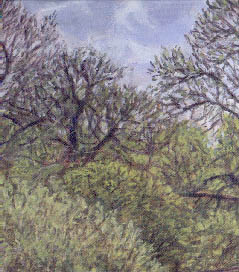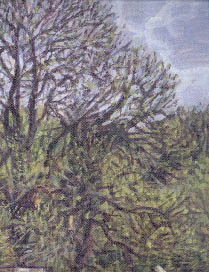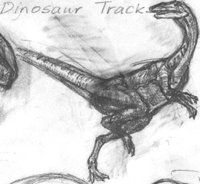


Bevan's Field
Wednesday 19th
April 2000




 Nature Diary
Rocks
History
Workshop
Links
Home Page
Nature Diary
Rocks
History
Workshop
Links
Home Page

 
IT MAY BE for just one day only, but we're able to eat outside again, after the dull wet weather. The wood is at a half way stage, the Hawthorns around the edge are greening, there are catkins in the willows and a froth of Blackthorn blossom at the edge of the field. But the Oaks and Ashes are still leafless.
The detail above is from Bevan's Field, an acrylic on canvas painting I made, on location in the back garden, in May 1996. I wanted to the blackthorn blossom to be the centre of the composition, but, by the time I'd finished the blossom had faded, so that's the way I painted it. I thought about re-titling it After the Blackthorn, but then thought I shouldn't choose a title that referred to something that wasn't in the picture.
 Apart from a Wren singing there's just the sound of the breeze in the trees. Apart from a Wren singing there's just the sound of the breeze in the trees.
The first Kingcup is beginning to open at the corner of the pond.
 I've been putting in an extra effort this week to complete my Coxley Valley booklet. I've been looking up details about Matthew Murray (1765 - 1831), an engineer who drew up schemes for operating some of the collieries in the valley. Along with engineer John Blenkinsop he introduced, at Middleton colliery near Leeds, the first successful steam locomotive to be used for useful work. This was in 1812; as a result of the Napoleonic Wars the cost of horse fodder had gone up, making the scheme worth attempting. (Richard Trevithick's locomotive of 1803 wasn't a great success). The locomotives were such a novelty that people walked from the villages from miles around to watch them in action.
I've been putting in an extra effort this week to complete my Coxley Valley booklet. I've been looking up details about Matthew Murray (1765 - 1831), an engineer who drew up schemes for operating some of the collieries in the valley. Along with engineer John Blenkinsop he introduced, at Middleton colliery near Leeds, the first successful steam locomotive to be used for useful work. This was in 1812; as a result of the Napoleonic Wars the cost of horse fodder had gone up, making the scheme worth attempting. (Richard Trevithick's locomotive of 1803 wasn't a great success). The locomotives were such a novelty that people walked from the villages from miles around to watch them in action.
The illustration is from my book Yorkshire Rock, a journey through time.
So this was;
- the first powered transport for everyday needs
- the first successful form of transport using fossil fuel
Since almost everything we use today has reached us via fossil-fueled transport and fossil fuels are now used for sea, air and space travel, you'd think Blenkinsop and Murray would be celebrities. I looked them up in my Chambers Biographical Dictionary. Blenkinsop; nothing. No mention of Murray either . . . although the dictionary does include his contemporary, John Murray, an actor who 'is credited with one or two bad plays.'
A more up to date biographical dictionary, the Cambridge, includes Murray, but doesn't mention his crucial contribution to powered transport.
 While working on a dinosaur poster last summer I looked up Professor Sir Richard Owen in the Cambridge dictionary. He was the zoologist who coined the word dinosaur, and gave us the first popular picture of the real live animal. Again no mention, but we do get two Robert Owens, father and son, who were social reformers.
While working on a dinosaur poster last summer I looked up Professor Sir Richard Owen in the Cambridge dictionary. He was the zoologist who coined the word dinosaur, and gave us the first popular picture of the real live animal. Again no mention, but we do get two Robert Owens, father and son, who were social reformers.
Dinosaurs and fossil fuels hold a lot of the clues about where we came from and where we might be going. But it's the people who write 'one or two bad plays' who are remembered.

Richard Bell,
wildlife illustrator
E-mail; 'richard@daelnet.co.uk'
 Next day
Previous day
Nature Diary
Wild West Yorkshire home page
Next day
Previous day
Nature Diary
Wild West Yorkshire home page

|




 I've been putting in an extra effort this week to complete my Coxley Valley booklet. I've been looking up details about Matthew Murray (1765 - 1831), an engineer who drew up schemes for operating some of the collieries in the valley. Along with engineer John Blenkinsop he introduced, at Middleton colliery near Leeds, the first successful steam locomotive to be used for useful work. This was in 1812; as a result of the Napoleonic Wars the cost of horse fodder had gone up, making the scheme worth attempting. (Richard Trevithick's locomotive of 1803 wasn't a great success). The locomotives were such a novelty that people walked from the villages from miles around to watch them in action.
I've been putting in an extra effort this week to complete my Coxley Valley booklet. I've been looking up details about Matthew Murray (1765 - 1831), an engineer who drew up schemes for operating some of the collieries in the valley. Along with engineer John Blenkinsop he introduced, at Middleton colliery near Leeds, the first successful steam locomotive to be used for useful work. This was in 1812; as a result of the Napoleonic Wars the cost of horse fodder had gone up, making the scheme worth attempting. (Richard Trevithick's locomotive of 1803 wasn't a great success). The locomotives were such a novelty that people walked from the villages from miles around to watch them in action. While working on a dinosaur poster last summer I looked up Professor Sir Richard Owen in the Cambridge dictionary. He was the zoologist who coined the word dinosaur, and gave us the first popular picture of the real live animal. Again no mention, but we do get two Robert Owens, father and son, who were social reformers.
While working on a dinosaur poster last summer I looked up Professor Sir Richard Owen in the Cambridge dictionary. He was the zoologist who coined the word dinosaur, and gave us the first popular picture of the real live animal. Again no mention, but we do get two Robert Owens, father and son, who were social reformers.